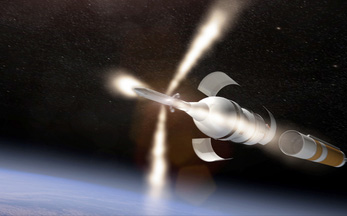
A NASA image of the Orion space capsule.
CAPE CANAVERAL (AP): NASA's quest to send astronauts out into the solar system begins this week with a two-laps-around-Earth test flight.
The new Orion spacecraft is not going to Mars just yet; Thursday's debut will be unmanned and last just 4œ hours.
But it will be the farthest a built-for-humans capsule has flown since the Apollo Moon missions, shooting 3,600 miles out into space in order to gain enough momentum to re-enter the atmosphere at a scorching 20,000 mph (32,000 kph).
The dry run, if all goes well, will end with a Pacific splashdown off Mexico's Baja coast. Navy ships will recover the capsule, a la Apollo, for future use.
This initial Orion is rigged with 1,200 sensors to gauge its durability for the day when astronauts do climb aboard during the decade ahead.
Advertised destinations include an asteroid to be corralled in lunar orbit for human exploration in the 2020s, followed by Mars in the 2030s.
Lockheed Martin Corp. built the capsule and is staging the USD 370 million test flight for NASA.
Orion is NASA's first new spacecraft for humans in more than a generation, succeeding the now-retired space shuttles.
Unlike the capsules under development by two US companies for space station crew transport, Orion is meant for the long haul, both in time and space; it would be supplemented with habitats for potential Mars trips.
"We need a spacecraft that's going to be sturdy enough and robust enough" to carry astronauts well beyond low-Earth orbit for weeks and months at a time, said Lockheed Martin's Bryan Austin, a former NASA shuttle flight director who will oversee Orion's maiden voyage.
For this orbital tryout, a Delta IV rocket will hoist Orion from Cape Canaveral Air Force Station. Liftoff is scheduled for 7:05 a.m. (1205 GMT), just after sunrise.
The rocket, with Orion and its launch escape tower at the tiptop, stretches 242 feet (73 meters) high.
Future Orion launches will use the mega rocket still under development by NASA, known as SLS or Space Launch System.
The first Orion-SLS launch is targeted for 2018, unmanned, followed by the first piloted mission in 2021.
No one at NASA is pleased with such a poky pace. At best, it will be seven years before astronauts fly Orion anywhere.
By comparison, it took eight years from the time President John Kennedy announced his intentions of landing a man on the Moon before John Glenn had even rocketed into orbit to Neil Armstrong and Buzz Aldrin's lunar boot prints in 1969.
Given the present budget situation, "it is what it is," said Kennedy Space Center's director Robert Cabana, a former astronaut.
And the presidential election ahead could bring further delays and uncertainties.
 Previous Article
Previous Article












The Indian Air Force, in its flight trials evaluation report submitted before the Defence Ministry l..
view articleAn insight into the Medium Multi-Role Combat Aircraft competition...
view articleSky enthusiasts can now spot the International Space Station (ISS) commanded by Indian-American astr..
view article